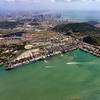Market Report: Long-Term Healthy LNG Ship Demand
There are a welter of new liquefaction and re-gasification projects worldwide. Of course not all will come to fruition. Figure 1 shows the most likely worldwide growth of LNG import capacity over the next 10 years.
In the Americas the U.S. is the leading market for development with not only excess capacity from its existing terminals still to fill but also a doubling of capacity due to expansion projects at existing terminals. In addition to this there are green and brown field import plant developments. Overall, the author believes that U.S. LNG import plant capacity will increase 10-fold over the next decade spurred by clean-burning electricity generation initiatives and political will to mitigate reliance upon Middle Eastern oil for energy supply. Mexico is also a key developing market with at least four plants likely to be developed — one in the Gulf and the rest on the West Coast. Taken together the U.S. and Mexico is destined to expand current LNG import demand by almost 50 percent.
Europe is also expanding import capacity although not so dramatically. The most robust market is Spain where there are plans well advanced for three plant expansions and for three new plant at well developed stages. New markets are appearing in both the U.K. and Portugal. Italy is likely to have two additional import terminals by the end of this decade and Turkey has one plant project that is likely to succeed given the current oversupply and economic slowdown being experienced. These projects will increase European LNG import capacity by about 250 percent by the end of the decade.
In Asia there are two key development markets — India and China. The former started this century with a dozen import plant, today the author believes only three or four may materialize and even they may struggle to survive. China has four plant under development. The largest of the world's LNG markets, Japan, has one plant under development and Korea also has one plant under development. Overall the Asian market will continue to be the single dominant market for LNG with just under half of the world's LNG import capacity.
Should these developments continue by the end of this decade it is possible that the U.S. could be the world's second largest market for LNG after Japan. However, we must remember that the world has been here before.
There is an adequate supply of LNG since global liquefaction facility project capacity is greater than re-gasification project capacity. Adding all these projects together and taking note of relationships between suppliers and consumers allows an estimate ship demand. Taking a view on the success of each development in terms of load factor enables several viewpoints to be taken modeling growth rates of 10 percent (Optimistic); eight percent (Realistic); and five percent (Pessimistic). The effect of ship retirements can be accounted for, as can be the effect of new ship deliveries.
It can be seen that ship supply is tracking the high growth rate scenario. Should the growth rate turn out to be lower then there will be ships delivered without immediate employment. The long-term outlook for these ships is still good. Over the next two years there are 38 ships that will be delivered. Combining this with the greater number of terminals becoming available it is highly likely that spot market development will become even more favorable and that the modus-operandii of crude operators is likely to develop where baseload shipping capacity is covered with long-term chartered or owned tonnage and peak capacities are covered by a mixture of short-term or spot chartered vessels. This is evidenced by existing importers re-negotiating supply contracts and an increasing number of short-term shipping fixtures. Over 50 spot cargoes have been delivered into the U.S. in 2002.
There will still be some LNG ship orders placed by the market makers over the next few years for their LNG import/export projects although not as many as placed in the past two years. The market followers amongst the energy companies are likely to absorb any spare ship capacity with short-term contracts. Given the average newbuild delivery period is 30 months (depending upon containment type) then newbuilding orders will need to be placed at latest by late 2004 assuming a growth rate of eight percent. Since 1985, the growth rate in internationally traded LNG has been just above seven percent (ref: Cedigaz) — without considering the political and environmental issues then this may well be expected to continue. Hence in the author's view, growth of internationally traded LNG is likely to follow a slightly higher growth scenario (eight percent). This article is a synopsis of the commercial part of the full paper presented at the North American LNG conference, Houston, Texas, November 18-20, 2002.














